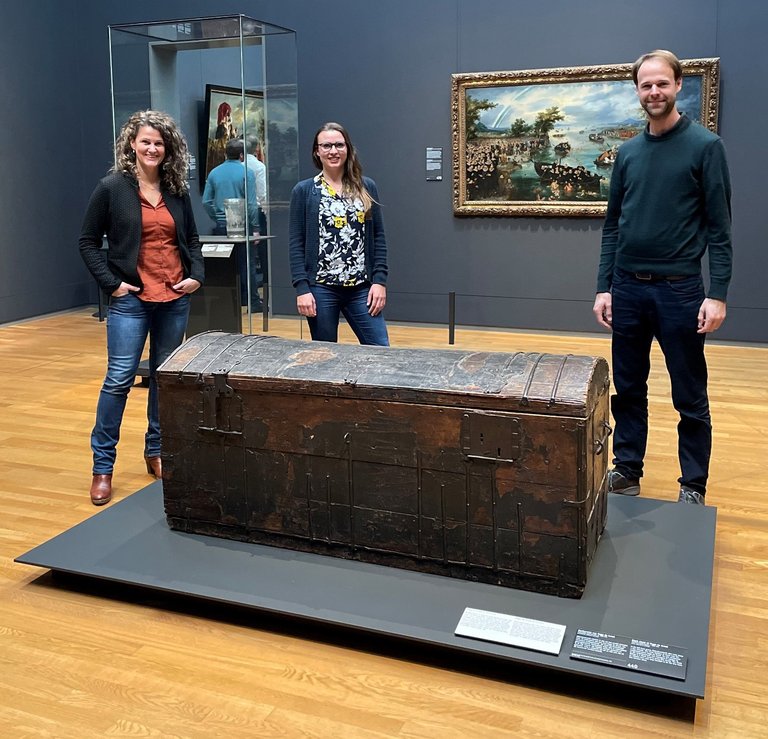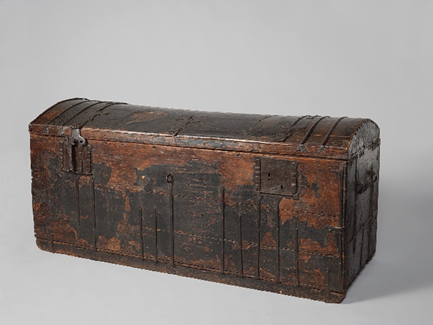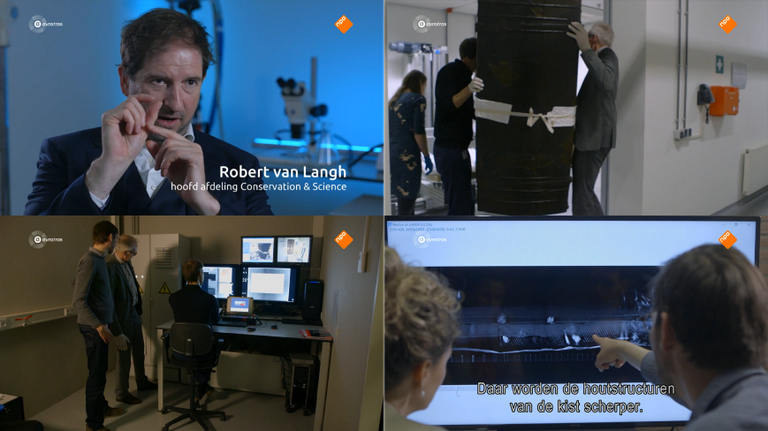The producers of TV series Historisch Bewijs placed the authenticity of the story surrounding iconic historical objects from the Rijksmuseum collection under investigation. One of the objects was a large bookchest, on permanent loan from the Koninklijk Oudheidkundig Genootschap, which supposedly served to hide Dutch jurist and humanist Hugo de Groot during his escape from imprisonment at Castle Loevestein in 1621. His escape is a well-known historical event that all Dutch children learn about at school.
The Rijksmuseum exhibits one of the bookchests thought to be the one used by Hugo de Groot. Another likely candidate is in possession of Museum Prinsenhof in Delft. The television broadcast posed the question: ‘Is it possible to determine which of these chests, if any, is the original one in which Hugo de Groot escaped Castle Loevestein?’ One way to approach this question was by exclusion. If the trees used to make the chests, were cut after the escape year of 1621, that chest could be discarded. Dendrochronology (tree-ring science) could therefore be used to date the wood and possibly provide the answer.

Team members with the Hugo de Groot Bookchest. From left to right: dendrochronologist Marta Domínguez Delmás (UvA), mathematician Francien Bossema (CWI) and furniture conservator Jan Dorscheid (Rijksmuseum).
Challenging research
The chests posed a challenge for dendrochronological research, as the transverse section of the wood, on which tree-ring widths are preferably measured, was inaccessible in most pine boards (it was covered either by other boards, by leather, or by metal fittings used for structural reinforcement). Therefore, the researchers decided to resort to X-ray imaging techniques to retrieve the tree-ring patterns through non-invasive methods and date them subsequently following standard dendrochronological procedures.
The large size of the chests limited the possibilities of implementing computed tomography (CT) scanning, which prompted the investigation of alternative scanning trajectories. The team efforts that followed led to the development of a new scanning method for large wooden objects.
Reconstruction algorithms
Due to the particular shape of tree rings (they appear as lines in a cross-section), the researchers discovered that they can be perfectly captured in X-ray images taken along a line trajectory, whereby the object is moved only sideways during scanning (as opposed to fully rotated in conventional CT). Those X-ray images were then processed through tailor-made reconstruction algorithms to produce tomographic images of the cross-section of the wood, in which ring widths could be measured for dendrochronological purposes.
This procedure yielded enough information to obtain sharp images of the tree rings (neatly capturing rings as narrow as 0.34 mm in test planks) which could then be used for dendrochronological measurements.


Hugo de Groot Bookchest (Rijksmuseum) and a detail of the image obtained using the line trajectory X-ray tomography technique, showing the tree rings.
“This is phenomenal, no one was able to do this thus far. Now this is what we call a Dutch invention”, said Dr. Robert van Langh, head of Conservation and Science at the Rijksmuseum at the television broadcast Historisch Bewijs (Historical Evidence), which aired 4 March 2020. The topic of his admiration was the X-ray line-trajectory tomography imaging method that the nominated team developed for the investigation of the Hugo de Groot chest that featured in this broadcast.
Variety of output
The technique represents a breakthrough for non-invasive dendrochronological research of large wooden objects from cultural heritage, and could only be achieved by combining the expertise of mathematicians, computer scientists, a dendrochronologist, furniture conservators and a technical art historian. This research led to a variety of output (see below), amongst which the episode of Historisch Bewijs, a peer reviewed article in Scientific Reports and a blog post. This manuscript features the bookchest as case study and discusses the newly developed scanning method with simulations and wooden test objects.

Screenshots from the TV broadcast ‘Historisch bewijs’, including Robert van Langh, Francien Bossema, Jan Dorscheid, Paul van Duin, Joost Batenburg and Marta Domínguez-Delmás.
NWO Team Science Award
The Hugo de Groot project was the beginning of a fruitful collaboration between researchers from various fields in which the individual expertise of each team member was highly regarded and complemented by the others to achieve extraordinary interdisciplinary research results. The NWO Team Science Award is a recognition for the most inspiring, diverse and successful team of researchers. The committee praised “the team’s talent development by giving chances to the junior researchers” and furthermore stated: “The disciplines that the team brings together are surprising and complement each other. The team needs its members to work together to answer their research questions and all the team members have added value”.
The research team consists of experts from a variety of disciplines within the Humanities (Archaeometry, Technical Art History, Conservation and Restoration) and the Physical Sciences (Mathematics, Computer Sciences). The team members are Francien Bossema, MSc. (CWI, Rijksmuseum), Dr. Marta Domínguez-Delmás (UvA, Rijksmuseum) and Jan Dorscheid, MSc. (Rijksmuseum), Dr. Sophia Coban (CWI), Dr. Alexander Kostenko (CWI), Dr. Willem-Jan Palenstijn (CWI), Paul van Duin (Rijksmuseum), Prof. Dr. Erma Hermens (UvA, Rijksmuseum) and Prof. Dr. Joost Batenburg (CWI/Leiden University).
Collaboration
The Team Science Award is not only of importance to the individual researchers, but to the involved institutions as well. Professor Fred Weerman, dean of the Faculty of Humanities of the UvA: “You can only solve the mystery of Hugo de Groot’s bookchest if you are as multidisciplinary and inventive as he was”. The academic co-director of the Amsterdam School for Heritage, Memory and Material Culture (AHM) of the UvA, professor Christa-Maria Lerm-Hayes, also praised the team’s work: "The AHM greatly values the team’s success. They have connected heritage and material culture through innovative research in the best way possible".
The director of CWI professor Ton de Kok states: “It shows how an open mind from CWI researchers to society can yield excellent research that matters in many different ways. For CWI this is an important award, as it shows how we continue a 75-year old tradition of collaboration on societally relevant problems with other disciplines and stakeholders.” Robert van Langh concludes: “History influences the future of science when multidisciplinary research leads to the development of innovative techniques.”
More information
Publication
- Bossema, Francien G.; Domínguez-Delmás, Marta, Palenstijn, Willem Jan; Kostenko, Alexander; Dorscheid, Jan; Coban, Sophia Bethany; Hermens, Erma; Batenburg, K. Joost, "A novel method for dendrochronology of large historical wooden objects using line trajectory X-ray tomography", Scientific Reports 11, 11024 (2021).
Television broadcasts
- Main episode Historisch Bewijs
- NPO Extra episode ‘Van microscoop tot isotoop – CT scans’
Blogs
- Blog written for CWI.nl by Adriaan Graas, edited by Francien Bossema
- NWO Team Science Award
- CWI's FleX-Ray lab
- Questions? Please contact Francien Bossema (CWI)
Header photo: ‘Hugo de Groot’s bookchest Team’ consisting of researchers from CWI, Universiteit van Amsterdam (UvA), Rijksmuseum and Universiteit Leiden (UL).
